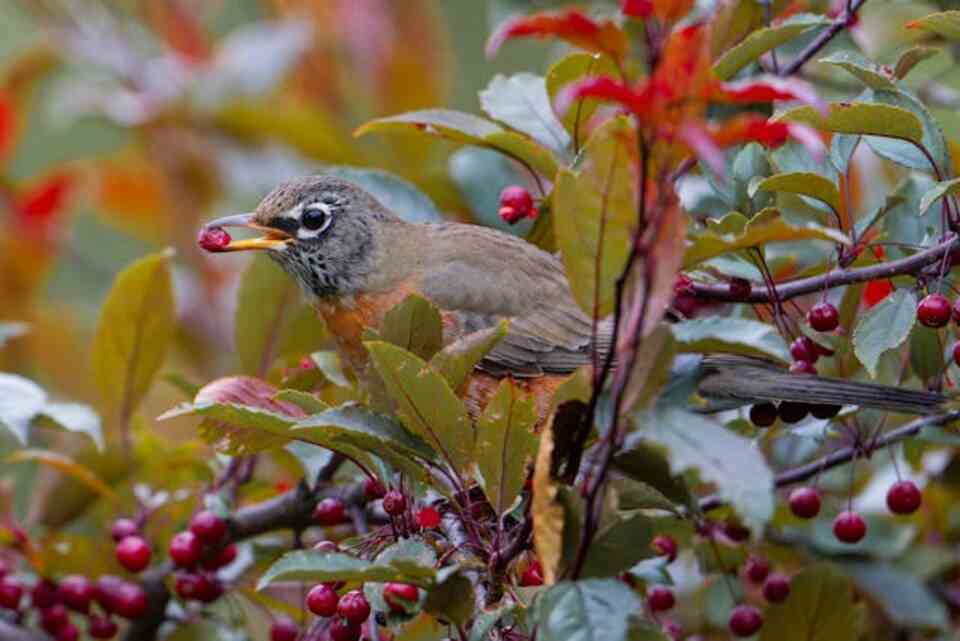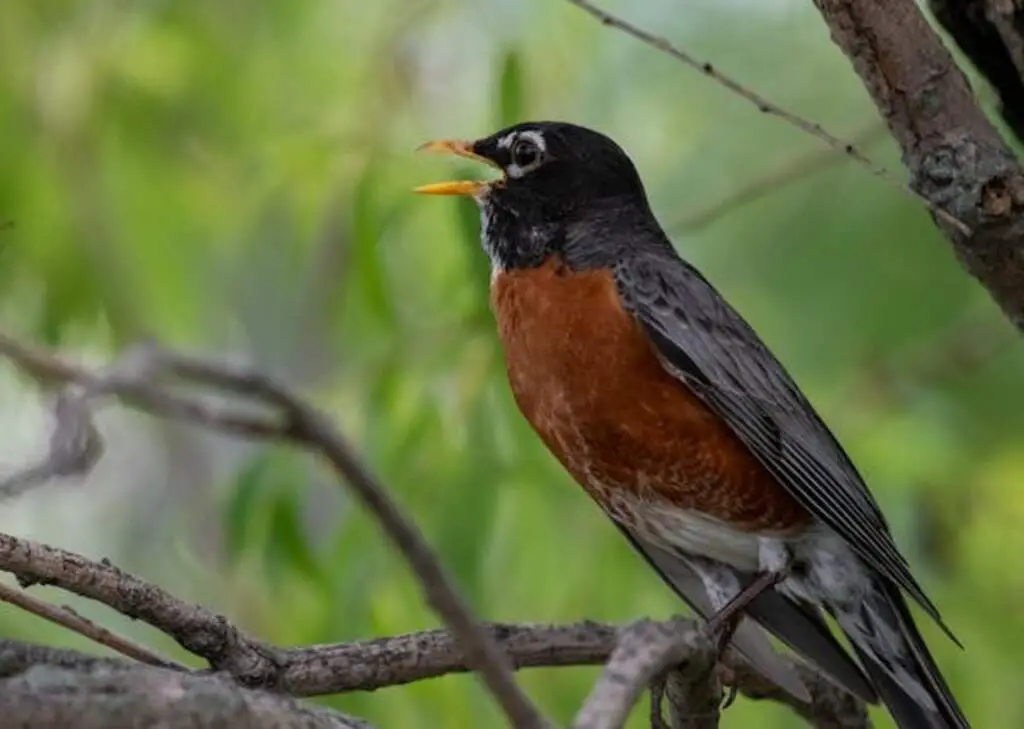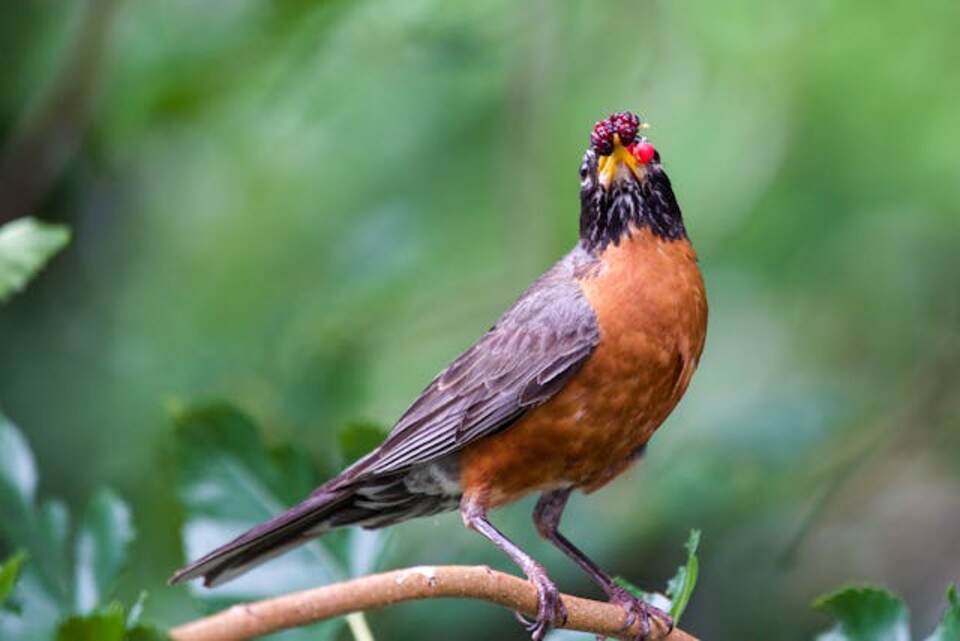Ever wondered, what do robins eat besides worms? While worms are a favorite food, robins have a varied diet. They also enjoy eating insects, berries, fruits, and seeds. During the spring and summer, they may feast on insects like beetles and caterpillars, while in the fall, fruits such as apples and cherries become a major part of their diet. In this article, we’ll explore the full range of foods that robins eat and how their diet changes with the seasons.
Table of Contents
Introduction to Robin Feeding Habits
Robins are omnivorous birds, meaning they eat both plant and animal matter. While the image of a robin tugging a worm from the ground is iconic, these adaptable birds have a much more varied palate than many people realize. Their diet changes with the seasons, availability of food sources, and their specific nutritional needs at different life stages.
The Varied Diet of Robins
Robins are opportunistic feeders, which means they’ll eat a wide variety of foods depending on what’s available. Here’s a quick overview of the main categories of food that make up a robin’s diet:
- Invertebrates (including worms)
- Fruits and berries
- Seeds and grains
- Other plant matter
Let’s break this down further with a table showing the approximate percentage of each food type in a robin’s diet during different seasons:
| Food Type | Spring | Summer | Fall | Winter |
|---|---|---|---|---|
| Invertebrates | 60% | 50% | 30% | 10% |
| Fruits/Berries | 20% | 40% | 60% | 80% |
| Seeds/Grains | 15% | 5% | 5% | 5% |
| Other Plant Matter | 5% | 5% | 5% | 5% |
As you can see, while invertebrates (including worms) make up a significant portion of their diet in spring and summer, fruits and berries become increasingly important as the year progresses.

Seasonal Changes in Robin Diets
Spring
In spring, as robins return from their wintering grounds or emerge from their winter territories, they focus heavily on protein-rich foods to fuel their breeding activities. This is when we’re most likely to see them hunting for worms on our lawns. However, they’re also consuming a variety of other invertebrates and early-ripening fruits.
Summer
Summer brings an abundance of insects and ripening fruits. Robins take full advantage of this bounty, feeding themselves and their growing chicks with a mix of protein-rich insects and sweet, energy-packed fruits.
Fall
As insects become scarcer in the fall, robins shift their diet more towards fruits and berries. This helps them build up fat reserves for migration or to survive the winter months ahead.
Winter
For robins that don’t migrate, winter is a challenging time. They rely heavily on whatever fruits and berries remain on trees and shrubs, often turning to ornamental plants in urban and suburban areas. They’ll also continue to hunt for insects and other invertebrates whenever possible, especially on warmer days when these creatures might become active.
Insects and Other Invertebrates
While earthworms are a favorite food, robins consume a wide variety of other invertebrates. Here’s a list of some common prey items:
- Beetles and their larvae (grubs)
- Caterpillars
- Flies and maggots
- Spiders
- Snails and slugs
- Millipedes and centipedes
- Crickets and grasshoppers
- Ants
- Termites
Robins have keen eyesight and can spot the slightest movement on the ground, making them efficient hunters of small invertebrates. They often employ a technique called “head-cocking,” where they tilt their head to the side, using one eye to scan the ground for movement. This behavior is thought to help them detect prey more effectively.
Hunting Techniques
Robins use several hunting techniques to catch invertebrates:
- Ground Probing: Using their beak to probe the soil for worms and grubs.
- Leaf Turning: Flipping over leaves to find insects hiding underneath.
- Hawking: Catching flying insects in mid-air, though this is less common than ground feeding.
- Gleaning: Picking insects off plants and tree bark.
Fruits and Berries
Fruits and berries are a crucial part of a robin’s diet, especially in the fall and winter. They provide essential nutrients and energy-rich sugars. Here’s a list of some fruits and berries that robins commonly eat:
- Blackberries
- Blueberries
- Raspberries
- Strawberries
- Mulberries
- Serviceberries
- Holly berries
- Dogwood berries
- Juniper berries
- Elderberries
- Honeysuckle berries
- Crabapples
- Wild grapes
- Cherries
- Sumac fruits
Nutritional Benefits of Fruits
Fruits provide robins with several important nutritional benefits:
- Carbohydrates: Quick energy for daily activities and migration.
- Vitamins: Especially vitamin C, which supports immune function.
- Antioxidants: Help protect cells from damage.
- Water Content: Helps keep birds hydrated, especially important in winter when water sources may be frozen.
Fruit Consumption Techniques
Robins have several techniques for eating fruits:
- Plucking: Picking berries directly from plants.
- Ground Feeding: Eating fallen fruits from the ground.
- Hanging: Balancing on branches to reach fruits.
- Gulp Feeding: Swallowing small fruits whole.
Seeds and Grains
While not as significant a part of their diet as invertebrates or fruits, robins do consume seeds and grains, especially when other food sources are scarce. Some seeds and grains that robins might eat include:
- Sunflower seeds (usually only when hulled)
- Millet
- Oats
- Corn (cracked or in meal form)
- Peanut hearts
- Nyjer seeds
It’s worth noting that robins are not typically seen at bird feeders offering only seeds, as their beaks are not well-adapted for cracking hard seed shells. However, they may visit feeders that offer softer foods or ground-scattered seeds.
Unexpected Food Sources
Robins are adaptable and opportunistic, sometimes turning to unexpected food sources, especially in urban or suburban environments. Some surprising items that robins have been observed eating include:
- Human Food Scraps: Bread crumbs, cooked rice, or even small pieces of meat left outdoors.
- Pet Food: Dry or wet cat and dog food left in outdoor dishes.
- Suet: While not a natural part of their diet, robins may eat suet from backyard feeders, especially in winter.
- Fish: Small minnows or fish fry in shallow water.
- Tree Sap: Occasionally, robins have been seen drinking sap from trees.
While these food items can provide temporary sustenance, it’s important to note that they should not make up a significant portion of a robin’s diet. Natural, species-appropriate foods are always best for their health and well-being.
Feeding Robins in Your Backyard
If you’re interested in attracting robins to your backyard, here are some tips for providing food they’ll appreciate:
- Plant Native Fruit-Bearing Plants: Trees and shrubs that produce berries will attract robins year-round.
- Offer Mealworms: Live or dried mealworms are a great protein source that robins love.
- Provide a Water Source: A birdbath or shallow water feature will attract robins for drinking and bathing.
- Create a Worm-Friendly Lawn: Avoid using pesticides and keep your lawn moist to encourage earthworms.
- Offer Fruit: Cut apples, grapes, or berries placed on a platform feeder can attract robins.
- Ground Feeding: Scatter softer seeds or fruits on the ground, as robins prefer to feed at ground level.
Robin-Friendly Backyard Feast
Here’s a table of robin-friendly foods you can offer in your backyard:
| Food Item | Presentation | Best Season |
|---|---|---|
| Mealworms | Dish or scattered | Spring/Summer |
| Berries | On plants or platform | All Year |
| Cut Fruit | Platform feeder | Fall/Winter |
| Softened Dog Food | Ground | Winter |
| Suet | Suet cage | Winter |
Remember, while feeding birds can be enjoyable and beneficial, it’s important not to make wild birds dependent on human-provided food. Offer supplemental food, especially in harsh weather, but allow robins to forage naturally as much as possible.
Robin Dietary Needs and Nutrition
Understanding the nutritional needs of robins helps explain their varied diet. Like all birds, robins require a balance of proteins, fats, carbohydrates, vitamins, and minerals to thrive.
Protein
Protein is crucial for robins, especially during the breeding season when they’re growing new feathers (molting) and producing eggs. Insects and other invertebrates are their primary source of protein.
Fats
Fats provide concentrated energy, essential for migration and winter survival. Berries high in natural fats, like dogwood berries, are particularly valuable.
Carbohydrates
Fruits provide most of the carbohydrates in a robin’s diet, offering quick energy for daily activities.
Vitamins and Minerals
Robins obtain various vitamins and minerals from their diverse diet:
- Vitamin A: Important for vision, found in insects and colorful berries.
- Vitamin D: Synthesized through exposure to sunlight, crucial for calcium absorption.
- Calcium: Necessary for egg production and bone health, obtained from snail shells and some insects.
- Iron: Found in earthworms and other invertebrates, important for oxygen transport in the blood.
Water
While robins get some water from their food, especially juicy fruits, they also need access to fresh water for drinking and bathing. In winter, when water sources may be frozen, robins may eat snow to stay hydrated.
Conclusion
As we’ve explored in this comprehensive guide, robins are far from picky eaters. Their adaptable diet allows them to thrive in a variety of habitats and survive changing seasons. From protein-rich insects to energy-packed berries, and even the occasional unexpected snack, robins demonstrate remarkable dietary flexibility.
Understanding what robins eat beyond worms not only satisfies our curiosity about these beloved birds but also helps us create more robin-friendly environments. By planting native fruit-bearing plants, maintaining healthy lawns that support invertebrates, and offering supplemental foods when appropriate, we can help support robin populations in our local ecosystems.
Remember, while it’s fascinating to observe and even supplement a robin’s diet, it’s equally important to respect their wild nature. The most beneficial thing we can do for robins and other wildlife is to preserve and restore natural habitats that provide a full range of their dietary needs throughout the year.
So the next time you see a robin in your yard, take a moment to appreciate the complexity of its dietary habits. That bird isn’t just looking for worms – it’s participating in a sophisticated foraging strategy honed by millions of years of evolution. And who knows? You might just spot it enjoying a berry, catching a beetle, or finding some other surprising snack that adds to our understanding of these remarkable birds.



